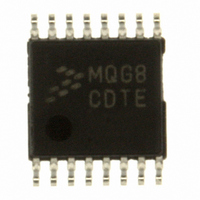MC9S08QG8CDTE Freescale Semiconductor, MC9S08QG8CDTE Datasheet - Page 168

MC9S08QG8CDTE
Manufacturer Part Number
MC9S08QG8CDTE
Description
IC MCU 8K FLASH 10MHZ 16-TSSOP
Manufacturer
Freescale Semiconductor
Series
HCS08r
Datasheet
1.MC9S08QG8CDTER.pdf
(314 pages)
Specifications of MC9S08QG8CDTE
Core Processor
HCS08
Core Size
8-Bit
Speed
20MHz
Connectivity
I²C, SCI, SPI
Peripherals
LVD, POR, PWM, WDT
Number Of I /o
12
Program Memory Size
8KB (8K x 8)
Program Memory Type
FLASH
Ram Size
512 x 8
Voltage - Supply (vcc/vdd)
1.8 V ~ 3.6 V
Data Converters
A/D 8x10b
Oscillator Type
Internal
Operating Temperature
-40°C ~ 85°C
Package / Case
16-TSSOP
Cpu Family
HCS08
Device Core Size
8b
Frequency (max)
20MHz
Interface Type
I2C/SCI/SPI
Total Internal Ram Size
512Byte
# I/os (max)
12
Number Of Timers - General Purpose
1
Operating Supply Voltage (typ)
2.5/3.3V
Operating Supply Voltage (max)
3.6V
Operating Supply Voltage (min)
1.8V
On-chip Adc
8-chx10-bit
Instruction Set Architecture
CISC
Operating Temp Range
-40C to 85C
Operating Temperature Classification
Industrial
Mounting
Surface Mount
Pin Count
16
Package Type
TSSOP
Processor Series
S08QG
Core
HCS08
Data Bus Width
8 bit
Data Ram Size
512 B
Maximum Clock Frequency
20 MHz
Number Of Programmable I/os
12
Number Of Timers
1
Operating Supply Voltage
1.8 V to 3.6 V
Maximum Operating Temperature
+ 85 C
Mounting Style
SMD/SMT
3rd Party Development Tools
EWS08
Development Tools By Supplier
DEMO9S08QG8E
Minimum Operating Temperature
- 40 C
Package
16TSSOP
Family Name
HCS08
Maximum Speed
20 MHz
For Use With
DEMO9S08QG8E - BOARD DEMO FOR MC9S08QG8
Lead Free Status / RoHS Status
Lead free / RoHS Compliant
Eeprom Size
-
Lead Free Status / Rohs Status
Compliant
Available stocks
Company
Part Number
Manufacturer
Quantity
Price
Company:
Part Number:
MC9S08QG8CDTE
Manufacturer:
ABB
Quantity:
101
Company:
Part Number:
MC9S08QG8CDTE
Manufacturer:
Freescale Semiconductor
Quantity:
41 991
Part Number:
MC9S08QG8CDTE
Manufacturer:
FREESCALE
Quantity:
20 000
Inter-Integrated Circuit (S08IICV1)
11.4.1.1
When the bus is free; i.e., no master device is engaging the bus (both SCL and SDA lines are at logical
high), a master may initiate communication by sending a START signal. As shown in
START signal is defined as a high-to-low transition of SDA while SCL is high. This signal denotes the
beginning of a new data transfer (each data transfer may contain several bytes of data) and brings all slaves
out of their idle states.
11.4.1.2
The first byte of data transferred immediately after the START signal is the slave address transmitted by
the master. This is a seven-bit calling address followed by a R/W bit. The R/W bit tells the slave the desired
direction of data transfer.
Only the slave with a calling address that matches the one transmitted by the master will respond by
sending back an acknowledge bit. This is done by pulling the SDA low at the 9th clock (see
No two slaves in the system may have the same address. If the IIC module is the master, it must not
transmit an address that is equal to its own slave address. The IIC cannot be master and slave at the same
time. However, if arbitration is lost during an address cycle, the IIC will revert to slave mode and operate
correctly even if it is being addressed by another master.
11.4.1.3
Before successful slave addressing is achieved, the data transfer can proceed byte-by-byte in a direction
specified by the R/W bit sent by the calling master.
All transfers that come after an address cycle are referred to as data transfers, even if they carry sub-address
information for the slave device
Each data byte is 8 bits long. Data may be changed only while SCL is low and must be held stable while
SCL is high as shown in
transferred first. Each data byte is followed by a 9th (acknowledge) bit, which is signalled from the
receiving device. An acknowledge is signalled by pulling the SDA low at the ninth clock. In summary, one
complete data transfer needs nine clock pulses.
If the slave receiver does not acknowledge the master in the 9th bit time, the SDA line must be left high
by the slave. The master interprets the failed acknowledge as an unsuccessful data transfer.
If the master receiver does not acknowledge the slave transmitter after a data byte transmission, the slave
interprets this as an end of data transfer and releases the SDA line.
In either case, the data transfer is aborted and the master does one of two things:
166
•
•
1 = Read transfer, the slave transmits data to the master.
0 = Write transfer, the master transmits data to the slave.
Relinquishes the bus by generating a STOP signal.
Commences a new calling by generating a repeated START signal.
START Signal
Slave Address Transmission
Data Transfer
Figure
MC9S08QG8 and MC9S08QG4 Data Sheet, Rev. 5
11-8. There is one clock pulse on SCL for each data bit, the MSB being
Freescale Semiconductor
Figure
Figure
11-8, a
11-8).











